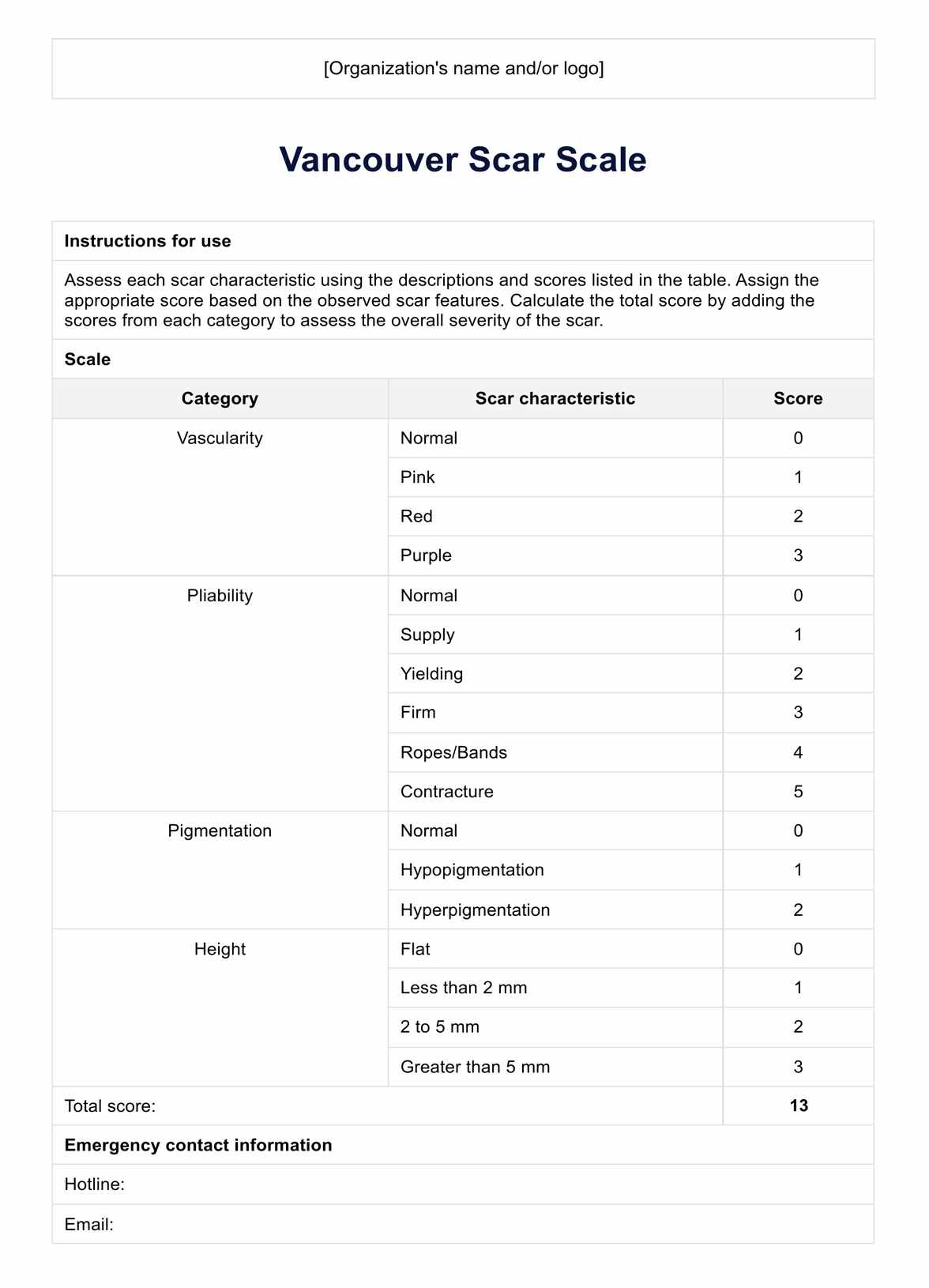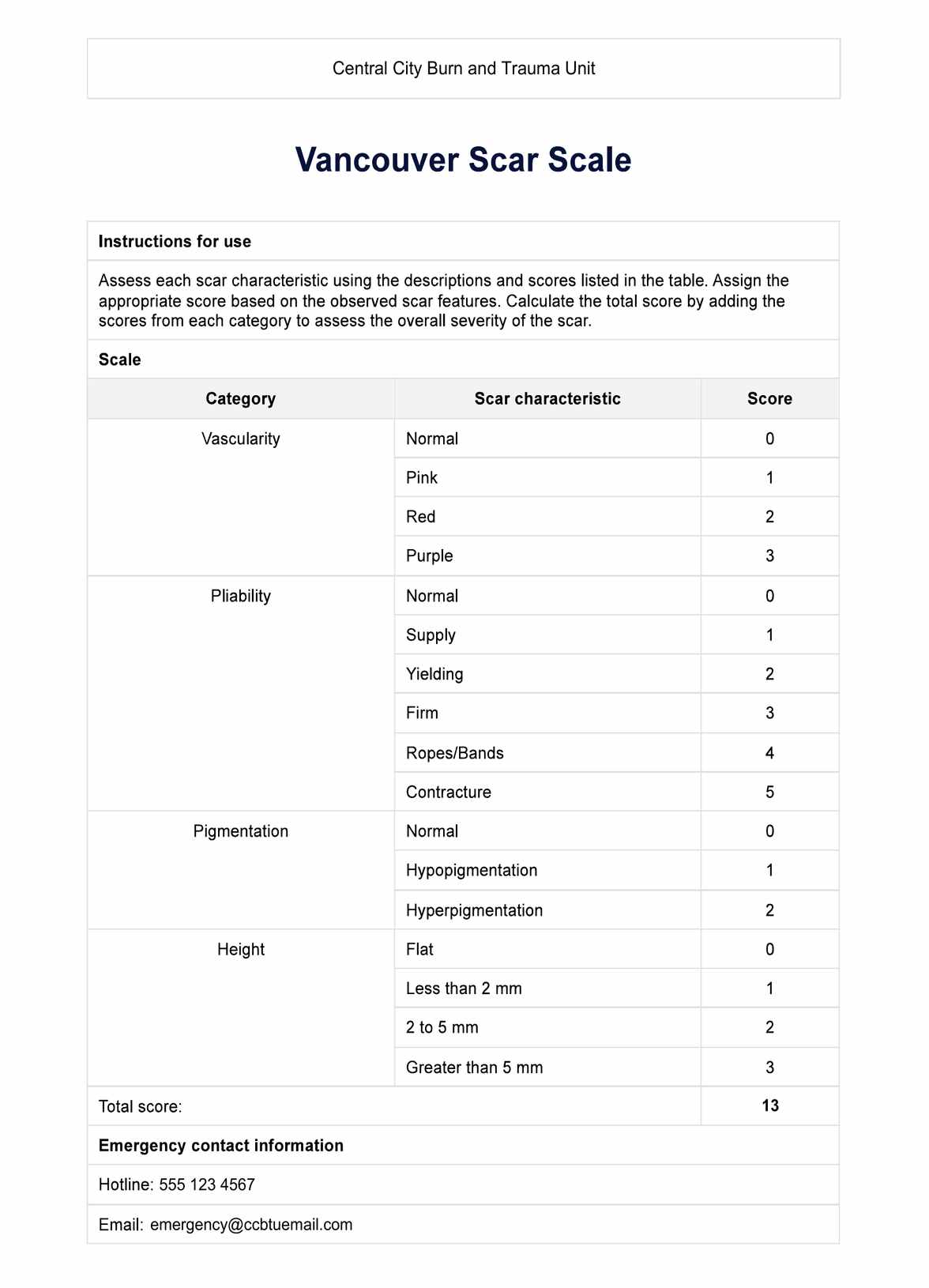Vancouver Scar Scale
Utilize our Vancouver Scar Scale template for precise burn scar assessments, enhancing treatment accuracy and educational outreach in medical settings.


What is the impact of burn scars?
Burn scars can have profound effects on patients, spanning physical, psychological, and social domains. Physically, burn scars can lead to significant discomfort and functional limitations. They often result in reduced elasticity of the skin, which can impair mobility and lead to pain during movement. Severe scars might also cause disfigurement, which can be permanent without surgical interventions.
Psychologically, the presence of visible scars can significantly impact a patient's self-esteem and body image. Many patients experience emotional distress, including symptoms of anxiety and depression, particularly if the scars are disfiguring or located in highly visible areas. The psychological impact can be as debilitating as the physical effects, sometimes necessitating psychological support or counseling.
Socially, individuals with burn scars may face stigmatization or social isolation due to visible differences. This can lead to difficulties in social interactions, professional opportunities, and personal relationships. The visibility of burn injury scars can evoke reactions from others that may lead to feelings of embarrassment or alienation for the patient.
Vancouver Scar Scale Template
Vancouver Scar Scale Example
Importance of burn scar assessments
Burn scar assessments are critical in the management and treatment of burn injuries. These evaluations are essential for several reasons:
- Determining treatment needs: By evaluating the severity, depth, and characteristics of the scar, clinicians can tailor treatment plans that may include surgery, rehabilitation, and other interventions to improve function and appearance.
- Monitoring progress: Regular assessments provide a means to monitor the healing process and evaluate the effectiveness of treatment strategies. This is crucial for making timely adjustments to the care plan to ensure optimal recovery.
- Preventing complications: Early and ongoing assessments can help prevent or mitigate complications associated with burn scars, such as contractures and excessive scarring. Early intervention can significantly improve outcomes by preventing the progression of scarring and improving skin elasticity.
- Psychological support: Understanding the emotional and social effects of scarring can guide support services, including counseling and support groups, to help patients cope with the visible reminders of their trauma.
Burn scar assessments usually require specific scales and methods, such as burn scar rating scales. We'll go over these next.
Different ways to assess burn scars
Assessing burn scars is crucial for managing and treating burn injuries effectively. Various scar assessment scales and methods have been developed to evaluate the characteristics and severity of burn scars objectively. These tools are essential for determining the appropriate treatment and monitoring the scar's progression or improvement over time.
Patient and observer scar assessment scale (POSAS)
The POSAS allows both the clinician and the patient to assess the scar. This scale includes parameters such as pain, itching, color, stiffness, thickness, and irregularity, with separate scores from the observer and the patient, offering a comprehensive view of the scar's physical and symptomatic profile.
Scar assessment by digital photography
Advancements in digital imaging allow for detailed analysis of scars through high-resolution photography. This method is often used in conjunction with software that can score scar photos through color and texture, providing an objective and reproducible way to monitor scar changes over time.
Laser Doppler imaging
This technique is used to assess the microcirculation within the scar tissue. Laser Doppler imaging can be particularly useful for evaluating the vascularity of hypertrophic scars and keloids, which may guide decisions regarding potential treatments like laser therapy or corticosteroid injections.
Vancouver Scar Scale
Finally, the Vancouver Scar Scale assesses burn scars based on vascularity, pliability, pigmentation, and height. This scale is instrumental in both clinical settings and research in effectively evaluating the severity and treatment response of burn scars.
A closer look at the Vancouver Scar Scale
The Vancouver Scar Scale is an integral tool used widely in both clinical practice and research to assess the severity and progression of burn scars. Developed in the late 1980s, this scale provides a structured method for evaluating the physical characteristics of scars, which is crucial for determining treatment efficacy and guiding clinical decisions. It is a relatively simple scale that provides a quantifiable measure of scar characteristics that are otherwise subjective in nature.
The Vancouver Scar Scale assigns scores across four categories: vascularity, pliability, pigmentation, and height. Each category has specific criteria:
- Vascularity is scored from 0 to 3, with higher scores indicating more pronounced discoloration ranging from pink to purple.
- Pliability measures scar flexibility, with scores ranging from 0 (normal) to 5 (contracture).
- Pigmentation differences are scored based on changes from normal skin color, with hypopigmentation and hyperpigmentation being noted.
- Height of the scar is scored based on its elevation above the skin.
The total score is the sum of each scar quality category, with higher scores indicating more severe scarring. Specific score ranges can guide treatment planning and effectiveness assessments. For instance:
- A total Vancouver Scar Scale score of 0-4 suggests mild scarring, which may require minimal or no treatment.
- Scores between 5 and 10 indicate moderate scarring that might benefit from therapeutic interventions such as silicone gel sheets or corticosteroid injections.
- Scores above 10 are usually associated with severe hypertrophic scars or keloids, often requiring more aggressive treatments like laser therapy or surgery.
Limitations of the Vancouver Scar Scale
While the Vancouver Scar Scale is highly valuable, it's important to recognize its limitations to utilize it effectively in clinical settings:
- Subjectivity: Some components of the scale, such as pigmentation and pliability, can be somewhat subjective and vary between observers. This variability can affect consistency and reproducibility across different assessments.
- Limited scope: The scale focuses primarily on physical characteristics and does not include other factors such as itching, pain, or functional impairment, which can be crucial for a comprehensive scar assessment.
- Inapplicability to all scar types: The Vancouver Scar Scale is optimized for hypertrophic scars and keloids, and may not be as effective for assessing other types of scars, such as atrophic or acne scars.
- Training requirements: Accurate use of the scale requires proper training. Without consistent training, scoring can vary significantly between different clinicians.
Understanding these limitations is essential for using the Vancouver Scar Scale appropriately, and complementing it with other assessment tools or clinical judgments to ensure a holistic approach to scar management.
How does our Vancouver Scar Scale template work?
Our Vancouver Scar Scale template makes it simple for healthcare professionals to objectively evaluate scar properties, incorporating a detailed scoring system for burn scars. It is crafted to serve as a quick reference and educational tool, particularly useful in settings with high burn risks or for training purposes.
Step 1: Access this template
Healthcare providers can access this template on the Carepatron platform. Available for both digital use and printing, it accommodates the needs of various environments, whether in clinical settings or educational workshops. Healthcare practices can also add their contact information to the template before distributing them to people who will use it.
Step 2: Explain and hand over the template
Before using the template, professionals must understand its components and how it functions as a reference tool. The template details each scar characteristic category—vascularity, pliability, pigmentation, and peight—and the scoring criteria for each. This explanation is vital for training new staff or educating students, patients, and related workers about the assessment process.
Step 3: Use as a reference during assessments
While the template does not contain fillable fields for findings, it is used alongside clinical assessments to guide the scoring of scars. By referring to the template, practitioners can ensure that they evaluate scars according to standardized criteria, promoting accuracy and consistency in assessments.
Step 4: Enhance educational and training sessions
The template also acts as a valuable educational tool during training sessions for workplace safety officials, medical students, or new healthcare staff. It provides a visual aid that helps illustrate the correct method to assess and score burn scars, ensuring learners understand the process.
This template not only facilitates a detailed assessment of burn scars but also ensures that all relevant data is captured systematically for better clinical outcomes and patient care.
Treatment for burn scars
Burn scars can present significant challenges, not just physically but also emotionally. Effective treatment is crucial for improving scar appearance, enhancing functionality, and supporting patients' emotional well-being. Here are some commonly used treatments for managing burn scars:
- Silicone gel sheets: These are used to flatten and soften hypertrophic scars. The sheets provide a protective layer that hydrates the scar, reduces its redness and discomfort, and can make the scar less noticeable over time.
- Pressure garments: Worn for 23 hours a day for up to two years, pressure garments help reduce scar thickness and increase pliability. They are particularly useful for large burn areas that are prone to developing thick scars.
- Corticosteroid injections: These are used to reduce itchiness, pain, and the size of raised scars. Repeated injections might be necessary every few weeks to achieve the best results, and they are often used in conjunction with other treatments.
- Laser therapy: Various types of lasers can be used to reduce scar redness, improve pliability, and even remove the outer layers of skin around a scar to promote a more natural appearance. Laser therapy can be particularly effective when started early and can require several sessions.
- Surgical revision: In cases where scars are severe, cause functional limitations, or are resistant to other treatments, restorative burn surgery may be considered. This can involve scar excision, skin grafts, or other reconstructive procedures to improve the range of motion and appearance.
It's important to note that treatment choice depends on the scar’s characteristics, location, and the patient's overall health. Consultation with a healthcare professional is essential to tailor the treatments to the patient's specific needs, ensuring the most effective and appropriate care.
Commonly asked questions
A scar is the body's natural way of healing and replacing lost or damaged skin. It typically comprises fibrous tissue that replaces normal skin after an injury.
Scar assessment involves evaluating the characteristics of a scar to understand its severity and impact. This can help in deciding the appropriate treatment strategies.
The Vancouver rating scale is a method used to evaluate the severity of scars based on several criteria, including vascularity, pliability, height, and pigmentation.







































































































